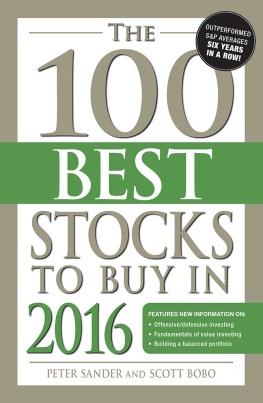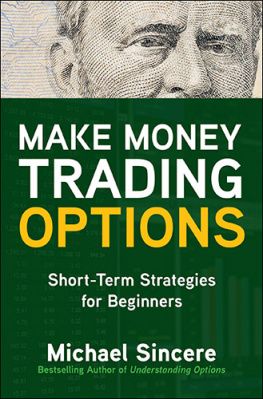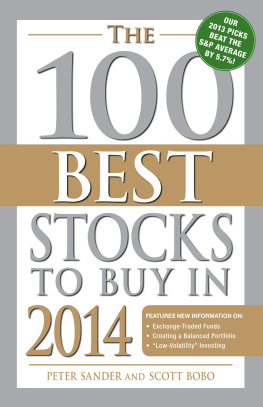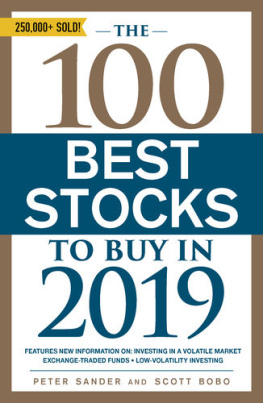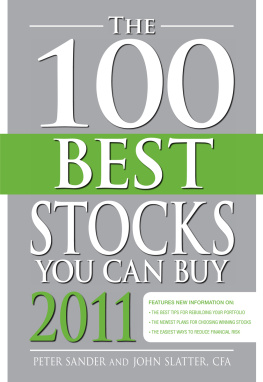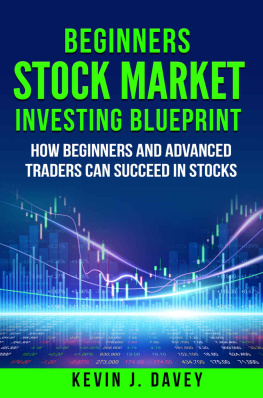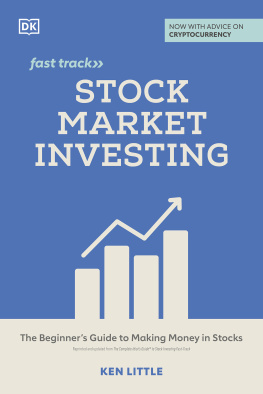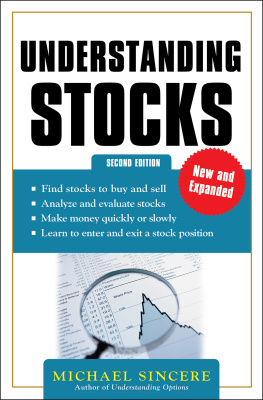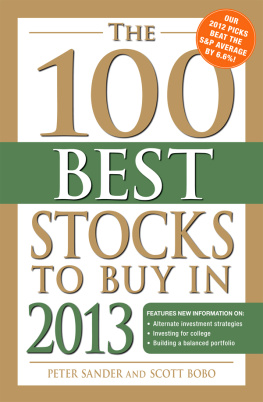Contents
Guide
THE
BEST
STOCKS
TO BUY IN
2016
PETER SANDER
AND
SCOTT BOBO

A VON , M ASSACHUSETTS
Contents
Dedication
We continue to dedicate this book to all of you active investors who have the sense of purpose and independence of thought to make your own investing decisionsor at least, to ask the right questions. You continue to be wise enoughand inquisitive enoughto realize that not all the answers can be found in one placeand smart enough to seek the convenience of a good place to start.
PART I
THE ART AND SCIENCE OF INVESTING IN STOCKS
By Peter Sander
The Art and Science of Investing in Stocks
To our surprise, once again, it didnt happen.
It? What it? What didnt happen? In a year when energy prices tanked, ISIS roiled the Mideast, another Grexit was threatened, a strong dollar crushed exports, and the San Francisco Giants won the World Series again, just what didnt happen?
Actually, there are two its that didnt happen.
The first it: the markets winning streak didnt end. The stock marketsin the U.S. anywayforged ahead again, though not so strongly as last year. Those of you who follow the markets or follow our book year after year will know that the markets have finished up six straight years. Last year we had once again bet that win streak to end. In fact, all along and through our six-year history weve really wanted to test our horses on the sloppy track of a down market.
Didnt happen.
The second it: Despite the fact that markets were up, not down, and that we continue to play defensive, which may not prove optimal in an up marketwe beat the markets again anyhow. Six straight years, a Sextuple Crown, if you will. We had thought that with the weight we place on U.S. exporters, and industrial and energy-related stocks, we might be doomed to finish out of the money even as the markets won.
That didnt happen, either.
So for another year well have to wait and see how well our 100 Best Stocks lists would run in a down market, because we havent seen one in the six years since we started putting our horses on the track for the running of that years 2010 100 Best Stocks list.
But most importantly, we still beat the up market. In fact, we scored a 15.0 percent gain versus a 12.7 percent gain in the S&P 500, dividends included; hardly a photo finish, but well cash our tickets (a few of them, anyway) and set out to enter the race again for 2016. Well do our best to put you in the winners circle again.
* * *
Surely, as the early months of 2015 wore on, we worried about our picks (as we do every year). As mentioned, weve always favored companies that do most of their business overseas. Theyre a way to play international and especially emerging-market growth while keeping business styles and accounting methods close to home. In fact, international sales generally serve to increase volumes of domestic companies as well; such scale drives down per-unit costs, making these multinational players more profitable.
We like more profitable. In fact, when you look at the big picture, international growth lies at the heart of how big companies can grow their earnings 10, 12, 15 percent a year against a backdrop of overall economic growth, as measured by GDP, running in the 24 percent range. Those of you who have watched the markets for years probably have wondered (or should have wondered, anyway) how stock markets can grow persistently at 810 percent for nearly 100 years, while the economy as a whole grows at something not even half of that. Part of it is inflation, but part of it is that major players in the markets find ways to grow their market share by buying smaller companies or crowding them outor by expanding their reach beyond our shores so as to transcend the limits of 24 percent U.S. growth. So strong overseas business is not only patriotic in the sense that it brings in valuable income from offshore, helping us fund our insatiable appetites for foreign goods, it also helps stimulate necessary growth in both revenues and profits to help our stocks prosper to the tune of 15 percent (and almost 24 percent last year) as previously described.
The main fly in the ointment comes with the strengthening dollar. When U.S. companies sell in local currency and translate those sales back to U.S. dollars, it can be painful when the value of those local currencies depreciates against those dollars. So we saw the refrain over and over again: Company X reported a revenue gain of 4 percent, which would have been 8 percent without currency headwinds. Indeed, as the year wore on and we saw such headlines repeated over and over, we began to really wonder if all of our eggs were in the wrong basket and whether we should have picked so many companies with more than 50 percent of sales overseas.
Then there was the energy thing. We had pared our energy holdings over the years as some of the bigger providers had run into growth headwinds, difficulties replacing reserves, and the increased risk of headline disasters like the Deepwater Horizon spill. Despite this trimming, we still had a lot of companies that serviced the energy business directly or indirectlylike Fluor, which builds refineries and other infrastructure; oilfield services giant Schlumberger; and companies like Praxair that supply specialty materials to the energy industry. Oil prices cratered 50 percent as OPEC and the Saudis in particular essentially tried to put the resurgent U.S. oil business out of business, and we wondered how our 100 Best list would fare in such an environmentand braced for the worst.
Fortunately, our excellent companies trudged through the currency headwinds fairly well for the most part. And the energy thingwell, energy is an input cost to a great many of the companies we follow (no surprise!). Too, related collateral damage softened prices in a lot of other commodities as well. Finally, our S&P 500 index benchmark was buffeted by the same headwinds. So, in the end, while some of our energy and commodity-related picks suffered (wed rather think of it as a buying opportunity), many of our other picks on the 100 Best list prospered.
The upshot? Marketsboth marketplaces and stock marketscan go through twists, turns, ruts, high points, and even backflips from time to time as shifts occur in supply and demand in the different sectors of those markets. But a good list of strong companies with excellent business models, combined with a reasonable diversification (we dont advocate owning all 100 Best Stocks unless you can afford to; maybe five to ten of our choices will do) should get you through these bumps with flying colors. Owning an excellent business even in a bad environment should pay off in the long termthat is and always will be our thesis and is one of the key pillars of our defensive strategy.
Well probably stick not only with that thesis but also the sub-theses of picking companies with strong overseas businesses and companies with strong positions in the energy industry.
* * *
As we wind down this opening statement well share a few other miscellaneous topics on our minds related to this edition and how we connect with you as readers and investors.
First of all, we continue to enjoy your feedback. I (Peter) first offered my e-mail address two years ago () as an experiment, and its worked quite well. Weve fielded many well-crafted questions that, frankly, we enjoyed answering. Not only do we appreciate the dialogs, but we learn from them. Keep them coming.

